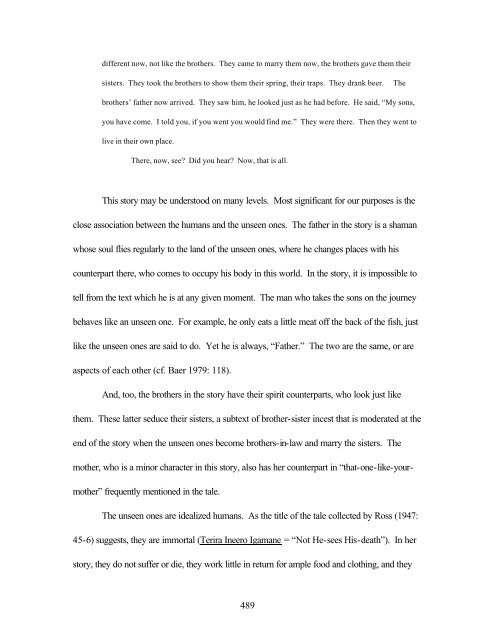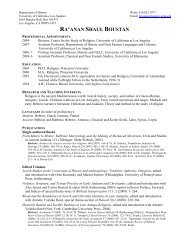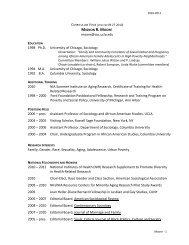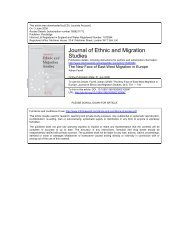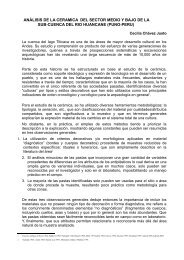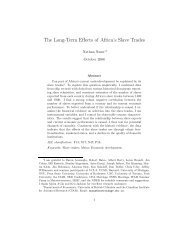433 Chapter Seven Cosmos For the Matsigenka of Shimaa, kameti ...
433 Chapter Seven Cosmos For the Matsigenka of Shimaa, kameti ...
433 Chapter Seven Cosmos For the Matsigenka of Shimaa, kameti ...
Create successful ePaper yourself
Turn your PDF publications into a flip-book with our unique Google optimized e-Paper software.
different now, not like <strong>the</strong> bro<strong>the</strong>rs. They came to marry <strong>the</strong>m now, <strong>the</strong> bro<strong>the</strong>rs gave <strong>the</strong>m <strong>the</strong>ir<br />
sisters. They took <strong>the</strong> bro<strong>the</strong>rs to show <strong>the</strong>m <strong>the</strong>ir spring, <strong>the</strong>ir traps. They drank beer.<br />
The<br />
bro<strong>the</strong>rs’ fa<strong>the</strong>r now arrived. They saw him, he looked just as he had before. He said, “My sons,<br />
you have come. I told you, if you went you would find me.” They were <strong>the</strong>re. Then <strong>the</strong>y went to<br />
live in <strong>the</strong>ir own place.<br />
There, now, see? Did you hear? Now, that is all.<br />
This story may be understood on many levels. Most significant for our purposes is <strong>the</strong><br />
close association between <strong>the</strong> humans and <strong>the</strong> unseen ones. The fa<strong>the</strong>r in <strong>the</strong> story is a shaman<br />
whose soul flies regularly to <strong>the</strong> land <strong>of</strong> <strong>the</strong> unseen ones, where he changes places with his<br />
counterpart <strong>the</strong>re, who comes to occupy his body in this world. In <strong>the</strong> story, it is impossible to<br />
tell from <strong>the</strong> text which he is at any given moment. The man who takes <strong>the</strong> sons on <strong>the</strong> journey<br />
behaves like an unseen one. <strong>For</strong> example, he only eats a little meat <strong>of</strong>f <strong>the</strong> back <strong>of</strong> <strong>the</strong> fish, just<br />
like <strong>the</strong> unseen ones are said to do. Yet he is always, “Fa<strong>the</strong>r.” The two are <strong>the</strong> same, or are<br />
aspects <strong>of</strong> each o<strong>the</strong>r (cf. Baer 1979: 118).<br />
And, too, <strong>the</strong> bro<strong>the</strong>rs in <strong>the</strong> story have <strong>the</strong>ir spirit counterparts, who look just like<br />
<strong>the</strong>m. These latter seduce <strong>the</strong>ir sisters, a subtext <strong>of</strong> bro<strong>the</strong>r-sister incest that is moderated at <strong>the</strong><br />
end <strong>of</strong> <strong>the</strong> story when <strong>the</strong> unseen ones become bro<strong>the</strong>rs-in-law and marry <strong>the</strong> sisters. The<br />
mo<strong>the</strong>r, who is a minor character in this story, also has her counterpart in “that-one-like-yourmo<strong>the</strong>r”<br />
frequently mentioned in <strong>the</strong> tale.<br />
The unseen ones are idealized humans. As <strong>the</strong> title <strong>of</strong> <strong>the</strong> tale collected by Ross (1947:<br />
45-6) suggests, <strong>the</strong>y are immortal (Terira Ineero Igamane = “Not He-sees His-death”). In her<br />
story, <strong>the</strong>y do not suffer or die, <strong>the</strong>y work little in return for ample food and clothing, and <strong>the</strong>y<br />
489


